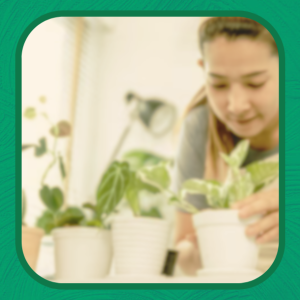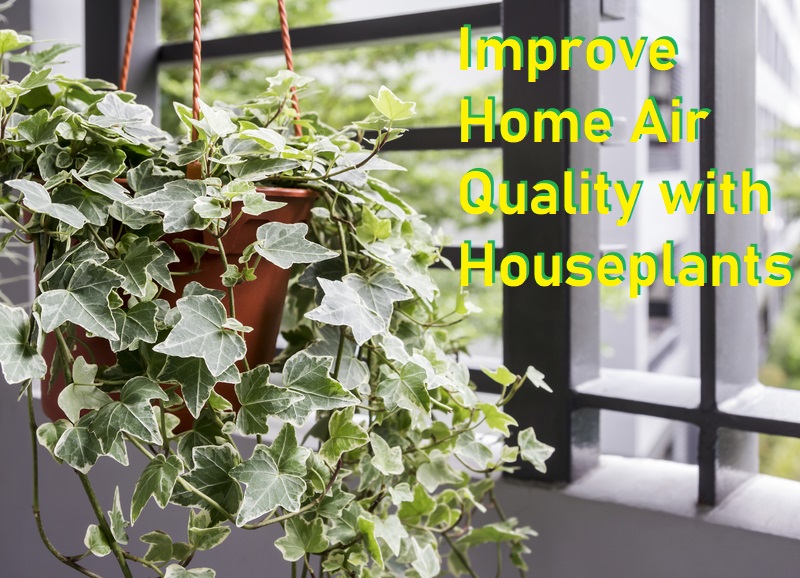HousePlantJoy is supported by our audience. When you purchase through one of our links, we may earn a small affiliate commission. As an Amazon Associate I earn from qualifying purchases. Your cost is not affected.
==================
Improving indoor air quality is essential to creating a healthier living environment. Modern homes often trap pollutants, leading to what is known as ‘indoor air pollution’, a stealthy health hazard that many of us might overlook. Fortunately, introducing houseplants into your indoor spaces can serve as a simple and natural remedy to clean the air. These green companions are more than just decorative elements. They play a significant role in filtering out common airborne toxins and providing much-needed oxygen.
Houseplants and Clean Air: The Role of Greenery in Enhancing Indoor Air Quality
Extensive studies have shed light on the remarkable ability of indoor plants to purify the air, with many species capable of absorbing harmful chemicals like formaldehyde and benzene. Selecting the right types of plants and positioning them strategically throughout your home can, therefore, significantly boost indoor air quality.
While houseplants can improve indoor air quality, it’s crucial to complement them with other air purification strategies for maximum benefit. Awareness about the limitations of relying solely on plants for air purification is equally important, as is routine maintenance and care of your indoor foliage.
Key Takeaways
- Houseplants can naturally reduce indoor air pollution and increase oxygen levels.
- Specific species are particularly effective at absorbing common airborne toxins.
- Optimal air quality requires combining plants with other purification methods.
The Importance of Clean Air in Indoor Environments
Maintaining clean air in your living and working spaces is crucial for your overall health and well-being. Indoor environments can often contain higher levels of pollutants than the air outside due to limited ventilation and the accumulation of contaminants from various sources. Integrating houseplants can be an effective way to enhance the air quality in these indoor spaces.
Common Indoor Air Pollutants:
- Volatile Organic Compounds (VOCs): Emitted from paints, cleaners, and furnishings.
- Particulate Matter: Includes dust, pollen, and pet dander.
- Carbon Monoxide and Nitrogen Dioxide: Byproducts of burning fuels.
Contaminants like these can contribute to a range of health problems, such as allergies, respiratory illnesses, headaches, and fatigue. Prolonged exposure to poor indoor air quality can have more severe, long-term effects on your health.
To ensure the air you breathe indoors is healthy, it’s important to:
- Increase Ventilation: Open windows or use air filtration systems to cycle fresh air into the space.
- Control Humidity: Keep indoor humidity levels between 30-50% to minimize mold growth.
- Minimize Pollutants: Choose natural cleaning products and reduce the use of aerosols and sprays.
Indoor plants can also play a role in improving air quality. Through the process of photosynthesis, plants can absorb gases and produce clean oxygen. Research has indicated that plants can modestly contribute to the removal of ozone and potentially reduce levels of nitrogen dioxide in indoor environments.
By being aware of the sources of indoor air pollution and taking steps to mitigate them, you can improve your indoor air quality and safeguard your health.
Overview of Houseplants
Houseplants are more than just decorative elements for your living space. They contribute significantly to improving indoor clean air quality.
Benefits of Houseplants for Indoor Air
Houseplants may enhance your home environment by removing certain toxins from the air, leading to healthier indoor spaces. Research has suggested that plants can absorb volatile organic compounds (VOCs) through photosynthesis, potentially reducing pollutants like benzene and formaldehyde.
Common Houseplants Used for Air Purification
Commonly used for air purification, the Spider Plant and Peace Lily are among the top choices for homeowners. A University of Birmingham study states that ordinary potted houseplants can improve indoor air quality. Some other houseplants known for their air-purifying abilities include:
- Aloe Vera: particularly effective at filtering out byproducts of cleaning products
- Snake Plant: an easy-to-care-for option that can absorb excessive amounts of carbon monoxide
- Bamboo Palm: thrives in low-light conditions and is great for filtering out trichloroethylene and benzene
Scientific Basis for Plants Improving Air Quality
The presence of houseplants could improve indoor air quality, a concept supported by certain scientific principles related to houseplants and clean air. Houseplants contribute to air purification largely through two natural processes: photosynthesis and the biological activity in the soil.
Photosynthesis and Air Purification
During photosynthesis, plants take in carbon dioxide (CO2) and release oxygen (O2), enhancing the air you breathe. This process is fundamental to air purification. A critical aspect of this is the plant’s ability to absorb some pollutants along with CO2, which can reduce indoor air contaminants.
- A study highlighted on Live Science suggests that although plants can contribute to removing ozone, their ability to purify air in this way might be modest, around 0.9-9%.
- Another research piece reviewed in Air Quality, Atmosphere & Health explains how potted plants can remove nitrogen dioxide (NO2), a potentially harmful compound.
Microorganisms in Soil as Air Purifiers
The soil in which plants grow houses microorganisms that play a role in air purification. As air passes through the soil, these microorganisms can break down and neutralize pollutants.
- The natural filtration achieved by the soil’s microbiome adds to the indoor air quality, as noted in research shared by NASA, where vents in plant pots allow air to be drawn through the soil for beneficial filtering.
- However, according to ScienceDirect, despite the plant microbiome’s role, the overall capacity of plants to significantly improve air quality in indoor settings is still a subject of ongoing research.
Optimizing Indoor Air Quality with Houseplants
Incorporating houseplants into your home can be a natural way to enhance indoor air quality. This section explores how to select, place, and care for air-purifying plants to create a healthier living environment.
Best Practices for Plant Care
Proper care is crucial to the health of your houseplants and their ability to improve clean air quality. Ensure consistent watering. Check the top inch of soil for dryness to determine when your plants need water.
Also, provide adequate light exposure based on the specific needs of each plant, which can range from low to high light intensity.
Selection and Placement of Plants
Select plants that thrive in your home’s environmental conditions to optimize their growth and air-purifying abilities. Place plants where they can get appropriate levels of sunlight and avoid drafty locations. For instance, placing a Snake Plant in a bedroom can be beneficial, as it converts CO2 to oxygen at night, contributing to improved sleep quality.
Air-Purifying Plants for Specific Pollutants
Identify common indoor pollutants and choose plants known for mitigating those contaminants. For example, the Spider Plant is recognized for reducing benzene and formaldehyde levels, common byproducts of cleaning products and furniture. A table of air-purifying plants and their targeted pollutants can provide a quick reference:
| Plant | Target Pollutants |
|---|---|
| Spider Plant | Benzene, Formaldehyde |
| Peace Lily | Ammonia, Benzene, VOCs |
| Rubber Plant | Formaldehyde |
| Boston Fern | Xylene, Formaldehyde |
Remember, while plants can contribute to better indoor air quality, they should complement other air-cleansing strategies, such as proper ventilation and the use of air purifiers.
Limitations and Considerations
In evaluating the role of houseplants in indoor air quality, it’s important to understand their limitations as well as explore complementary methods that can enhance air purification. Integrating houseplants and clean air strategies into your daily routine can significantly improve the health and comfort of your indoor spaces.
Limitations of Houseplants as Air Purifiers
Research suggests that while houseplants can absorb certain pollutants, the effectiveness of plants to purify indoor air is limited. For example, a publication by the Illinois Extension indicates that houseplants alone may not significantly alter the air quality in a typical home setting. Moreover, a study highlighted by Science in the News from Harvard suggests that an impractical quantity of plants per square foot would be necessary to match the air-cleaning capacity of natural ventilation.
Complementary Air Cleaning Solutions
Given the limitations of houseplants, it is wise to incorporate additional air-cleaning strategies. Mechanical air purifiers with HEPA filters can effectively remove particulate matter, and ensuring proper ventilation is vital for exchanging indoor air with outdoor air, which helps in diluting indoor pollutants. Moreover, Popular Science points to the potential of houseplants to remove specific urban pollutants like nitrogen dioxide, although this is typically in conjunction with other air-cleaning practices.
Innovations in Houseplants and Air Purification
Recent advancements have expanded your options for enhancing indoor air quality through innovative houseplants. Biotechnology has played a significant role in this development, creating plant varieties specifically designed to filter out common indoor pollutants. These plants can absorb harmful volatile organic compounds (VOCs) like formaldehyde and benzene more effectively than traditional houseplants.
- Bioengineered Plants: Researchers are experimenting with plants that have been genetically modified to carry specific traits aimed at air purification. For instance, scientists at the University of Washington have created a new type of pothos ivy that breaks down indoor pollutants at a higher rate.
- Integrated Systems: Your houseplants can now be part of larger home automation systems designed to improve air quality. These systems often pair houseplants with sensors and filters to maximize their purifying effects.
Furthermore, start-ups are contributing to this field by creating self-contained ecosystems. These can house plants that work in tandem with microorganisms to neutralize pollutants more effectively than plants alone. An example of this is the future of air purifying plants, which embraces both the natural purifying properties of plants and technological aids to enhance indoor air quality.
Key Benefits of Innovations in Air-Purifying Houseplants:
- Efficiency: The latest houseplants are more efficient in filtering air.
- Design: They integrate seamlessly into modern home aesthetics.
- Ease of Care: Engineered to require less maintenance while providing benefits.
As you incorporate these innovative houseplants into your home, be mindful of your indoor environment’s specific needs. Each plant has unique characteristics suitable for different types of pollutants, spaces, and preferences.
Maintaining Air Quality: Long-Term Strategies
To ensure sustained improvement in your indoor air quality, you need to implement a series of strategic measures. Source control is the cornerstone of maintaining a healthy environment. This involves identifying potential pollutants and reducing their presence in your home. For instance, using low-emission furnishings and household products can lower the amount of volatile organic compounds (VOCs).
- Improve Ventilation: Increase outdoor air exchange by opening windows when weather permits or using exhaust fans, particularly in high moisture areas like kitchens and bathrooms, to mitigate mold growth.
- Regular Maintenance: Keep your HVAC system in good working order with regular filter changes. Consider the addition of air cleaners to remove pollutants further, especially if you have allergies or respiratory concerns.
- Indoor Plants: Incorporating houseplants can modestly improve air quality by absorbing certain pollutants, though it’s important to understand their limitations and not rely on them solely for purification purposes.
You can maintain a healthier indoor air environment by integrating these strategies into your daily life. Including houseplants and clean air practices will enhance your efforts. Regularly performing these tasks will become second nature, providing long-term benefits to your health and indoor spaces’ comfort.
Video Credit: @SciShow
Wrapping It Up
Houseplants are great for improving indoor air quality. Choose plants like spider plants or peace lilies. They absorb toxins and add oxygen to your space.
Place them in different rooms for maximum benefit. Remember, healthy plants need regular care. Enjoy cleaner air and a greener home with these plants!
Frequently Asked Questions
Which houseplants are most effective at purifying indoor air?
Some indoor plants are renowned for their ability to filter harmful toxins. For instance, the NASA Clean Air Study highlights species like the peace lily and snake plant as potent air purifiers.
How do indoor plants contribute to overall air quality improvement?
Plants can improve air quality through photosynthesis, absorbing carbon dioxide and releasing oxygen. They also can remove toxins from the air, as detailed in a study on nitrogen dioxide removal by indoor plants.
What are the scientifically proven benefits of having air-purifying plants indoors?
Scientific research indicates that indoor plants can modestly reduce certain pollutants like formaldehyde and benzene levels. Additionally, a study published in Air Quality, Atmosphere & Health confirms that indoor plants can remove nitrogen dioxide.
Can the presence of plants in the home significantly increase oxygen levels?
While plants do release oxygen into the air, the increase in oxygen levels within a home due to plants is generally small. However, they do contribute to fresher air during photosynthesis.
How much can houseplants realistically improve indoor air quality?
Houseplants can contribute to improved indoor air quality, but their impact is often limited. They make modest contributions to removing airborne toxins, so they should be part of a broader strategy for improving air quality.
In what ways do houseplants potentially benefit mental health?
Beyond air purification, indoor plants may offer mental health benefits such as reduced stress and improved mood. Interacting with plants can have a calming effect, which contributes to overall well-being.
Learn More About Houseplants!
Discover more types of houseplants, their benefits, and how to care for them with us! Join us on Facebook, Instagram, and Twitter for beautiful photos, plant care tips, and a community that celebrates the joy of indoor gardening.
Facebook: https://www.facebook.com/houseplantjoyblog
Instagram: http://instagram.com/houseplantjoy20
Twitter: https://twitter.com/HouseplantJoy
Let’s nurture our green spaces together!













